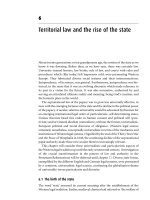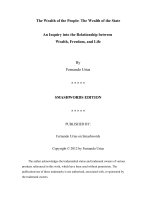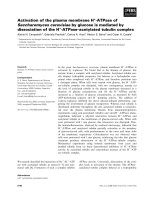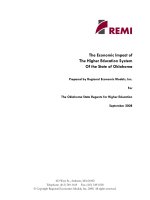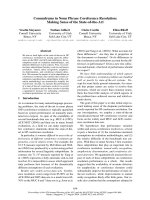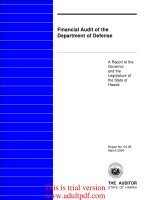Bull of N.Y. Museum Bulletin 105 Botany 9 Report of the state botanist, H. Peck 1905
Bạn đang xem bản rút gọn của tài liệu. Xem và tải ngay bản đầy đủ của tài liệu tại đây (10.99 MB, 114 trang )
Published monthly by th«
New York State Education Department
AUGUST 1006
BULLETIN 381
New York State Museum
JOHN
CHARLES
M.
H.
CLARKE
Director
State Botanist
PECK
Bulletin
105
BOTANY 9
REPORT OF THE STATE BOTANIST 1905
PAGE
PAGB
Introduction. . . . . . . . . . . . . . . . . .
5
Species added to the herbarium
8
Contributors and their contributions
,
.. 10
Species not before reported.. . .. . I 5
Remarks and observations. . . . . 30
Edible fungi.................. 36
Species of Crataegus Found within Twenty Miles of Albany.
C. S. SARGENT & C. H. PECK. 44
Explanation of plates. . . . . . . . . . 79
Index
'
'"
'
103
ALBANY
NBW YORK: STATE EDUCATION DEPARTMBNT
1906
KbIo6m-Ja6-a500
Price 50 cents
EDUCATIOR DEPARTMENT
LL.D.
HOWARD
J.
EDWARDJ.
AUGUSTUS
S.
Secretary to the CommiuiJeoer
HARLAN
H.
HORNER
B.A.
Director of State Um-atJ
EDWIN
M.
H.
ANDBRSON
CLARKE
Ph.D. LL.D.
CWe'. of DlybDOJDI
Accounts,
WILLIAM: MASON
D.
M.A.
SULLIVAN
New York State Education Department
Science Division, January
2,
1906
Hon. Andrew S. Draper LL.D.
Commissioner of Education
SIR: I herewith transmit for publication as a bulletin of the State
Museum the annual report of the State Botanist for the year ending
September 30, 190 5.
Very respectfully ,
JOHN
M.
CLARKE
Director
Approved for publication, January 5, 1906
Commissioner of Education
New York State Education Department
New York State Museum
JOHN
CHARLES
M.
H.
Director
State Botanist
CLARKE
PECK
Bulletin
105
BOTANY 9
REPORT OF THE STATE BOTANIST 1905
To John M. Clarke, Director of Science Division:
.I have the honor of submitting to you the following report of
work done in the botanical department of the State Museum during
the year 1905.
Specimens of plants for the State herbarium have been collected
in the counties of Albany, Allegany, Essex, Livingston, Rensselaer,
Saratoga, Steuben, Suffolk, Warren and Wyoming. Specimens
have been contributed that were collected in the counties of Albany,
Chautauqua, Columbia, Fulton, Herkimer, Monroe, Oneida, Onondaga, Orleans, Oswego, Queens, Rensselaer, Suffolk, Tompkins, Warren, Washington, Wayne and Westchester. Specimens have also been
contributed or sent for identification that were collected in the states
of California, Connecticut, Indiana, Iowa, Maine, Maryland, Massachusetts, Michigan, Minnesota, Missouri, Nebraska, New Jersey,
North Carolina, Pennsylvania and Virginia; also in the District of
Columbia, and in the country of Mexico and the provinces of Alberta, British 'Columbia, New Brunswick and Ontario.
The number of New York species added to the herbarium is 277.
Of these, 76 are new to the herbarium. A list of the names of these
species may be found under the title "Plants added to the herbarium."
The number of contributions received, 'including specimens sent
for identification, when their character and condition was such as to
make their preservation desirable, is 63. A list of the names of the
contributors and their respective contributions is given under the
title cc Contributors and their contributions."
One of the 'most notable of these contributions consists of a bell
jar containing about 6 quarts of dried specimens of an edible
REPORT OF THE STATE BOTANIST
1905
7
The number of species of plants identified for correspondents and
others who have sent or brought specimens to the office of the
Botanist for this purpose is 60I. The number of persons for whom
identifications have been made is 86.
The work of testing our wild mushrooms for their edible qualities
has been continued. The number of species tried and approved is
I I.
Descriptions of these have been written and constitute a chapter on edible fungi. They are illustrated on 10 plates by colored
figures of natural size. Similar figures of four new species of fungi
have been prepared on two plates. The number of species and
varieties of New York edible mushrooms figured and described up to
the present time is 172.
Mr Stewart H. Burnham was employed as temporary assistant
during July, August and September. He continued the work begun by him last year and was chiefly engaged in disinfecting, arranging and labeling specimens. He also assisted in conducting
the correspondence of the office and in the identification of specimens sent by correspondents.
Respectfully submitted
CHARLES H. PECK
5 tate Botanist
Office of the State Botanist
Albany October I) 1905
8
c.
c.
c.
c.
c.
'!'n'Cb O,10 rI l & paeoenrm F1'.
unifactum
REPORT OF THE STATE BOTANIST
Arnanitopsis vaginata (Bull.) Raze
A.
volvata (Pk.) Sacco
Arnelanchier oligocarpa (M x.)
Aralia n udicaulis L.
Arctium lappa L.
Artemisia caudata M x.
Asplenium eben. hortonae Dav.
A.
eben. incisum Howe
Betula lenta L.
B.
papyrifera Marsh.
B.
populifolia Marsh.
Bidens bipinnata L.
Boletus aureipes Pk.
B.
bicolor Pk.
B.
castaneus Bull.
B.
chromapes Frost
B.
chrysenteron Fr.
B.
felleus Bull.
B.
frostii Russ.
B.
rugosiceps Pk.
B.
russellii Frost
B.
subaureus Pk.
Bovista plumbea Pers.
Bulgaria rufa Schwa
B.
rufa magna s».
Cassia chamaecrista L.
C"
nictitans L.
Chimaphila umbellata (L.) Nutt.
Cicuta maculata L. .
Clitocybe ochropurpurea Berk.
Clitopilus noveboracensis Pte,
C.
prunulus (Scop.) Fr..
Collybia dryophila (Bull.) Fr.
Comus amomum Mill.
C.
candidissima Marsh.
C.
circinata L'Her.
Cortinarius amarus Pk,
C.
bolaris (Pers.) Fr.
C.
corrugatus Pk.
C.
heliotropicus Pk.
C.
semisanguineus (Fr.)
C.
torvus Fr.
Crataegus acclivis Sarge
C.
champlainensis Sarge
C.
coccinea L.
C.
durobrivensis Sarge
C.
ferentaria Sarge
C.
gemmosa Sarge
C.
oxyacantha L.
C.
succulenta Lk.
Drosera rotund. comosa Fern.
1905
9
Elatine americana (Pursh) Arn.
Entomosporium maculatum Lev.
Epipactis viridiflora (H oftm.)
Equisetum hyemale L.
E.
variegatum Schleich.
Fornes conchatus (Pers.) Fr.
F.
rimosus Berk,
Gentiana quinquefolia L.
Gyromitra esculenta (Pers.) Fr.
Gyrostachys gracilis (Bigel..)
Hibiscus moscheutos L.
Hicoria glabra (Mill.) Britton
Hordeum hexastichon L.
Hydnum albonigrum Pk.
H.
aurantiacum A. {:I S.
H.
caput-ursi Fr:
H.
mucidum Pers.
H.
rufescens Pets.
H.
schiedermayeri H But.
H.
scrobiculatum Fr. ~
. H.
septentrionalis Fr.
H.
spongiosipes Pk.
H.
vellereum Pk.
Hygrophorus peckii Atk.
Hypholoma perplexum Pk,
Hypocrea citrina (Pers.) Fr.
Hypomyces lactifluorum (Schw.)
Ilex vert. cyclophylla Robins.
Inocybe flocculosa Berk.
Iris pseudacorus L.
Irpex nodulosus Pk,
J uglans cinerea L.
JUl1CUS
brachycephalus (Engelm.)
Lactarius brevis Pk,
L.
camphoratus (Bull.)
L.
fuliginosus Fr.
L'
indigo Schwa
L.
parvulus Pk.
L.
scrobiculatus (Scop.)
L.
serifluus (DC.) Fr.
L.
so~didus n:
L.
subdulcis (Bull.) Fr.
L.
trivialis Fr.
L.
vellereus Fr.
Lathyrus maritimus (L.) Bigot.
L.
ochroleucus Hook.
Lentinus cochleatus Fr.
Lenzites sepieria Fr.
Lychnis chalcedonica L. ~
Lysimachia quadrifolia L.
L.
vulgaris L.
REPORT OF THE STATE BOTANIST
1905
II
Mrs P. H. Dudley, New York
Melanthium latifolium Desr.
Miss Alice Eastwood, San Francisco Cal.
Hirneola polytricha Mont.
,- Montagnites candollei Fr.
Hydnum caput-ursi Fr.
Mrs L. L. Goodrich, Syracuse
I Trillium grandiflorum (1~1x.) Salisb.
Mrs T. J. Leach, Syracuse
Iris pseudacorus L.
Miss J. A. Moses, Jamestown
Hordeum hexastichon L.
Mrs F. W. Patterson, Washington D. C.
Lentinus spretus Pk,
Mrs F. C. Sherman, Syracuse
Tricholoma paeonium Fr.
I Boletus chrysenteron Fr.
Miss T. L. Smith, Worcester Mass.
Corticium lilacino-fuscum B. & C.
I Hydnum cinnabarinum Schw.
Phlebia radiata Fr.
Miss M. L. Sutliff, Sacramento Cal.
.
Galera reticulata Pk.
l Marasmius sutliffae Pk.
Hypholoma incertum Pk,
I Rhizopogon luteolus Fr.
Miss A. E. Tilton, Seal Harbor Me.
Hydnum suaveolens Scop,
Miss Adeline VanHorne, Montreal Can.
Armillaria im perialis Fr.
Mrs Elizabeth Watrous, New York
Pterospora andromedea N utt,
Mrs M. S. Whetstone, Minneapolis Minn.
Clitocybe candicans Pers.
I Lentinus obconicus Pk.
F. H. Ames, Brooklyn
Clitocybe trullisata Ellis
J. C. Arthur, Lafayette Ind.
Coleosporium campanulae (Pers.ii.eu.
Puccinia andropogonis Schso.
C.
vernoniae B. & C.
P.
schedonnardi K. <51 G.
Peridermium holwayi Syd,
Uredo panici Arth.
P.
ornarnentale Arth.
Uromyces hedysari paniculata Schw.
H. J. Banker, Greencastle Ind.
Hydnum' versipelle Fr.
Polyporus underwoodii Murr.
Thelephora intybacea Pers.
P.
berkeleyi Fr.
Craterellus clavatus (Pers.) Fr.
P.
poripes Fr.
I
w.w.
:I. P..
York
REPORT OF THE STATE BOTANIST
1905
13
o. E. Fischer, Detroit Mich.
Amanita cothumata Atk.
" Bulgaria Tufa Schur.
Annularia sphaerospora Pk.
I Peziza odorata t».
B. D. Gilbert, Clayville
Webera acuminata Schp.
N. M. Glatfelter, St Louis Mo.
Inocybe desquamans t».
Lepiota nudipes
Lentinus microspermus Pk,
Russula nigrescentipes Pk,
I
r».
w. R. Griffiths, Douglaston
Calochortus um bellatus Wood
Cephas Guillet, Toronto Can.
I Psilocybe foenisecii
Galera later. albicolor Pk.
(Pers.)
J. V. Haberer, Utica
Achroanthes unifolia (Mx.) Rat.
Hieracium venosum L.
Alsine gram. lanceolata F ensl.
Hypericum canadense L.
Antennaria amoglossa Greene
Hex vert. cyclophylla Robins.
Betula populifolia Marsh.
Juncus tenuis anthelatus Wieg.
Botrychium obliq. habereri Gilb.
Lathyrus maritimus L.
Lemna minor L.
Callitriche heterophylla Pursh
Carex albicans. W illd,
L.
trisulca L.
C.
castanea Wahl.
Limnorchis huronensis Rydb.
C.
muhlenbergii Schk.
Lycopodium inundatum L.
Monarda mollis L.
C.
schweinitzii Dew.
Ranunculus repens L.
Ceanothus americanus L.
Corallorhiza multiflora Nutt.
Rhynchospora fusca (L.) R. & S.
C.
multo flavida
R.·
glomerata (L.) Vahl
Scirpus subterminalis Torr.
Drosera intermedia Hayne
D.
rot. comosa .Fern.
Sparganium angustifolium M»,
Triosteum aurantiacum Bielen.
Elatine americana (Pursh) Arn.
Equisetum hyem. affine Eaton
Vaccinium penn. angustifolium (A it.)
E.
hyem.intennedium Eaton Veronica chamaedrys L.
Xanthoxylon americanum Mill.
E.
littorale Kuehl.
Xyris caroliniana Walt.
E.
varieg. nelsoni Eaton
X.
montana Ries
Galium aparine L.
r».
C. C. Hanmer, East Hartford Ct.
I Irpex molHs B: & C.
Agaricus arv, purpurascens eke.
Craterellus pogonati Pk,
I Merulius tremellosus Schrad.
J. W. Harshberger, Philadelphia Pa.
Specimens of 190 species of Pocono plateau plants
M. E. Hard, Chillicothe O.
Armillaria nardosmia Ellis
Cordyceps herculea Sekiu.
Cyclomyces greenei Berk.
I
Hydnum adustum Schw.
. H.
spongiosipes Pk,
I Trametesrubescens A. & S.
A. A.
P.
c.
G. B.
REPORT OF THE STATE BOTANIST
1905
Perley Spaulding, St Louis Mo.
Daedalea ambigua Berk.
I
obtusus Berk.
Fornes ribis (Schutn:) Fr.
I P.
scruposus Fr.
E. B. Sterling, Trenton N. J.
Cantharellus aurantiacus Fr.
I
Fr.
Cordyceps sinensis (Berk.) Sacco
Pleurotus bretschneideri K alchb,
I
R. H. Stevens, Detroit Mich.
Guepinia bicolor
r».
F. C. Stewart, Geneva
, Gloeosporium riessii S. Ct S.
Sporotricnurn anthophilum
I
t».
D. R. Sumstine, Kittanning Pa.
Cordyceps capitata (H olmsk.) Lk.
W. B. Varnum, Albany
Stropharia melasperma (Bull.) Fr.
E. A. White, Storrs Ct.
Amanitopsis volvata (Pk.) Sacco
Collybia tuberosa (Bull.) Fr.
I
T. E. Wilcox, Washington D. C.
Cortinarius anomalus Fr.
B. C. Williams, Newark
Polyporus frondosus Fr.
Osaka Mushroom Merchants Association, St Louis Mo.
Pleurotus bretschneideri Kalchb,
SPECIES NOT BEFORE REPORTED
Actaea ebumea Rydb.
Meadowdale and Karner, Albany co. May, in flower. July, in
fruit. Formerly considered a form of Act a e a alb a with
slender. pedicels.
Aecidium trientalis Tranz.
On living leaves of star flower, T r i e n tal i sam e ric a n a .
East Lake George marsh. June. S. H. Burnham.
Anthostoma gastrina (Fr.) Sacco
Dead bark of hickory. Crown Point, Essex co.
Boletus acidus n. sp..
PLATE T, FIG. 1-6
Pileus fleshy, rather thin, firm, convex, very glutinous when moist,
yellowish white, the margin of young plants often appendiculate
with fragments of the whitish fioccoseend glutinous' veil, flesh
16
l,;U1tOP311US Stttl8.DrlUI,OSl1S
n. sp.
REPORT OF THE STATE BOTANIST
1905
17
Pileus 1-1.5 inches broad; stem I-I.$ inches long, 2-4 lines thick.
Woods. Pittsford, Monroe co. September. F. S. Boughton.
The color of the stem of this species indicates a relationship with
such species as Cor tin a r ius san g u i n e u sand C. c i n nab a r i nus. The discoverer of the species describes the colors
of the cap and gills as very similar to those of eli toe y b e
o c h r 0 pur pur ea. The red stern and violet or purplish
violet gills of the young plant make it a beautiful and very attractive species.
Crataegus acuminata Sarg.i
The acuminate thorn is closely related to C. s t r c e t era e
and C. g 1 a u cop h y 11 a , but it may be separated from the first
by the absence of wrinkles from the leaves, and from the second by
the absence of glaucous hues from them.
Crataegus ambrosia Sarg,
The ambrosial thorn is so closely allied to the Hall thorn that they
are not readily distinguished from each other when in flower, but
with the full development of the leaves and fruit they are easily
separated, the leaves being broader and the fruit of the ambrosial
thorn being much larger and fewer in a cluster. It also persists
later in the season. The bushes are red with fruit to the end of
November.
Crataegus asperifolia Sarg.
The roughish-leaved thorn is similar in its general characters to the
rubicund thorn, C. rub i c u n d a , from which it may be separated by its glabrous calyx tube, which is also less reddish, more
glandular calyx lobes and shorter pointed leaves. The petioles
in our specimens are also generally shorter. The fruit of typical
C. asp e r.i f 0 1i a is described as having yellow flesh, but in our
specimens it becomes tinged with red late in the season.
Crataegus beckiana Sallg.
The Beck thorn in some of its characters is suggestive of C.
rho m b i f 0 1i a, but it is a much larger treelike shrub with
thicker leaves, glabrous calyx tube and with large droopingclusters
of fruit.
Crataegus caesariata Sarg.
The hairy thorn belongs to the group Coccineae and when in
flower it might be taken to be a form of C . C 0 C c i n ea. Its
1 The descriptions of this and other new species of this genus will be found
in the chapter on species of Crataegus found within 20 miles of Albanr.
REPORT OF THE STATE BOTANIST 1905
20
are more
c.
and
su ccul
Crataegus oblongifolia
leaved thorn
to the group Molles and is reto C. x c usa. Its flowers
the anthers more
colored than in
form of C. e x c
and
much
The
It
REPORT OF THE STATE BOTANIST
1905
21
It is broadly rounded or almost truncate at the base and slightly
narrowed toward the apex. The plants bear fruit abundantly
when only 4 or 6 feet tall, but they sometimes become 12 to 16
feet tall. They grow on rather light but rocky soil,
Crataegus pentandra Sarg.
The five stamened thorn, in its typical form, is said to have five
stamens and to be a tree. Our forms are mostly shrubs and the
stamens vary from 5 to 10 in flowers on the same shrub.
Crataegus polita Sarge
The polished thorn has been found in only one locality in our territory. I t there grows in poor rocky soil.
Crataegus rhombifolia Sarge
The rhombic leaved thorn belongs to the thin leaved section of
the group Tomentosae. It is, with us, a shrub of moderate size and
has flowers with 10 stamens and pink anthers. The pedicels are
hairy and the calyx tube is also more or less hairy. The species is
rather common in the vicinity of Albany.
Crataegus robbinsiana Sarge
The Robbins thorn sometimes forms a small tree but in the vicinity
of Albany it is more often a shrub. The appearance of the 'leaves
suggests a relationship to such species of the group Intricatae as
C. i n t ric a t a and C. foe tid a, but the fruit is pruinose
and the species is referable to the -group Pruinosae,
Crataegus rubrocarnea Sarg.
The red fleshed thorn takes its name from the deep red color of
the flesh of the fully ripened fruit. I t is closely related to C. rubi c u n d a but may be distinguished from it by its more globose
fruit in fewer fruited clusters and more persistent calyx lobes. It
is at present limited to a single locality.
Crataegus sejuncta Sarg.
"The separated thorn is allied to the polished thorn, C. pol ita,
froIiit~which it is separated by its short, stout, hairy pedicels, more
numerous stamens and rather larger crimson fruit. It is a large
shrub.
.
Entoloma:B.avifolium n. sp.
PLATE S, FIG. <)-15
Pileus thin but firm, broadly convex or nearly plane, glabrous,
hYirophanous, watery white and sometimes slightly striatulate on
Exoascus cecicomopnuus
The
Exoascu
is not
E. c o n f u
Geopyxis nebulosa
l~~a..Vln9' wood.
Sacco
C.E. Fairman.
Geranium sibiricum L.
The Siberian cranesbill is an introduced
p.len~tlttlLUV and
at
lY,...,nUil"'f1"'1llY
Gloeosporium rlessii Schl, & Sacco
Geneva. October.
C. Stewart,
D. B.
REPORT OF THE STATE BOTANIST 1905
23
the free development of the pileus. When young, the pileus is
whitish or white tinged with yellow. It soon assumes a buff color,
with the margin commonly
with blue and becoming a darker
blue where bruised. In old specimens the center or sometimes the
whole becomes ferruginous brown. The aculei are at first white
but they become brown or ferruginous brown with age. The spores
are purplish brown, subglobose or oval, .00016 of an inch in diameter.
The plant has a farinaceous odor when cut or bruised. It is
sometimes cespitose. It grows under" hemlock trees. Horicon, Warren co. July.
Hypomyces camphorati n. sp.
Subiculum thin, effused, overrunning and obliterating the
hymenium of the host plant, yellow; perithecia numerous, minute,
immersed in the subiculum, the ostiolum exposed, brown; asci very
long, .005-.006 of an inch (sporiferous part), eight spored; spores
monostichous, oblong fusiform, continuous, acute or slightly
cuspidate at each end, .0005-.0006 of an inch long, .00016-.0002
broad.
On the hymenium of Lac tar ius cam p h a rat us.
Port Jefferson, Suffolk co. August.
Closely allied to H. vol e m i Pk. from which it is distinguished
by its yellow subiculum, its longer asci and acute or cuspidate
spores.
Hypomyces lateritius (Fr.) Tu!.
On the hymenium of Lac tar ius i n dig o.
Monroe co. F. S. Boughton.
Pittsford,
Inocybe diminuta n. sp.
Pileus thin, hemispheric becoming convex or nearly plane,
squamose with hairy, erect or squarrose scales in the center, fibrillose on the margin, grayish brown; lamellae sub distant , broadly
sinuate, adnexed, ventricose, at first whitish, then brownish or
rusty brown; stem short, firm, solid, silky fibrillose, whitish in the
upper part, grayish brown and subsquamulose toward the base;
spores subglobose, nodulose, .0'0°3-.0004 of an inch long, .0'003
broad.
Pileus 3-6 lines broad; stem 4-8 lines long, about I line thick.
Bare compact soil in wood roads. Wading River. August.
A small but distinct species belonging to the section Lacerae,
Lactarlus rimosellus Pk,
lines thick .
Railroad
REPORT OF THE STATE BOTANIST
1905
Living leaves of peppermint, Men t hap i per ita. Lakeport, Madison co. July.
The diseased tissue shrinks below the level of the surrounding
healthy tissue and eventually separates from it and falls away,
leaving, circular holes in the leaves.
Marasmius longistriatus n. sp.
PLATE S, FIG. 1-4
Pileus membranaceous, convex becoming
with a central
depression or sometimes broadly infundibuliform, moist when
young and striate almost to the center, bay-brown when moist,
reddish gray when dry; lamellae thin, narrow, close, adnate, un.equal, whitish;' stem equal, externally cartilaginous, stuffed or
hollow, covered with a grayish downy pubescence which is sometimes longer at the base.
Pileus 3-6 lines 'broad; stem 8-12 lines long, .5 of a line thick.
.Under pine and hemlock 'trees. Bolton Landing. July.
This resembles M. sub n u d u s in color but it is a much
smaller plant with long fine striae on the pileus and with much
closer lamellae. The central depression resembles that of Coprinus plicatilis.
Melanogaster durissimus eke.
Menands, Albany co. September 1904. A single specimen,
somewhat smaller than the type form and without the strong odor
attributed to that form, was found. Its hardness is remarkable
and proves the appropriate character of the specific name. The
type form was found in India, but specimens of the species have
been reported from California by Dr H. W. Harkness. It is manifestly a species rarely found, but one having a wide range.
Merulius pruni n. sp.
Effused, thin, separable from- the matrix, soft, with a definite
whitish or pallid scarcely byssin margin; folds forming angular or
irregular pores with dentate or sometimes irpiciform dissepiments,
ecru drab when fresh, darker orsubcervine when dry.
Bark of wild red cherry, P run u s pen n s y 1van i ca.
Horicon. July.
It forms patches several inches long and broad, but these appear
as if formed by the confluence of many small orbicular patches,
the hymenium being faintly marked by concentric ridges or elevated
lines. The texture is soft, and somewhat waxy yet slightly tenacious
and the margin is nearly glabrous. The specimens are sterile.
